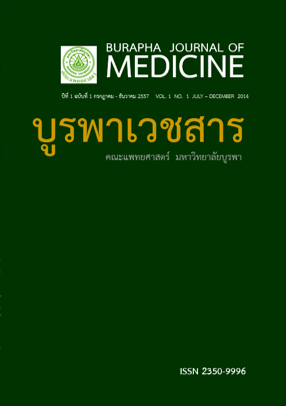Prevalence and Consequences of Spouse Conflict in Primary Care
คำสำคัญ:
Primary care setting, Spousal conflict, Marital conflict, Prevalence, Consequencesบทคัดย่อ
Objective The purpose of this study was to identify the prevalence, the potential risk factors and
the consequences of spousal conflict among patients consulting physicians in a primary care
setting.
Methods Stratified random sampling of 460 participants from a university primary care setting
was conducted by using the spousal conflict questionnaires with Likert’s scale. Its alpha coefficient
reliability was 0.814. The percentage, chi-square, odds ratio, and logistic regression were
used to analyze data.
Results Findings revealed that 83.9% of the sample had conflicts with their spouses during the
previous 12 months. The conflict events occurred seldom and occasionally at 30.2%, while often
(once or twice a month) and always (every week) at 59.1%. Young adult women and a high school
level of education of men were less likely to have conflict with their spouses. One partner decision
making was 1.698 times (95%CI 1.058-2.726) of having spousal conflict as compared to jointly
decision making. Regular alcohol consumption by women was more likely to have conflict than
by men at 4.589 times (95% CI 1.307-16.116) and 2.122 times (95% CI 1.413-3.187) respectively as
compared to those who did not drink. Avoiding was the most commonly used conflict managing
method, following by verbal abuse and physical abuse. After management of conflict, more
closeness and affective bond among spouses was 17.3% and unpleasant relationship was 82.4%.
Conclusions Findings indicate that conflict between spouses is a prevalent health problem in
primary care setting. The magnitude and patterns of conflict between spouses were
established. During patient care, healthcare providers should take spousal relationship, conflicting
matter between partnership and factors associated with violence into consideration in order
to decrease and prevent escalating conflict and domestic violence.
เอกสารอ้างอิง
structure, and context. Curr Dir Psychol Sci.
2003; 12: 23–27.
2. Merriam Webster’s medical desk dictionary.
Massachusetts: Merriam-Webster, Incorpo
rated; 1986. p.159.
3. Omorogb SK, Obetoh GI, Odion WE. Causes
and management of domestic conflicts
among couples. The Esan case. J Soc Sci.
2010; 24: 57-63.
4. Wilmot WW, Hocker JL. Interpersonal
conflict, 5th ed. Boston: McGraw-Hill; 1998.
5. Aekplakorn W, Kongsakon R. Intimate partner
violence among women in slum communi
ties in Bangkok, Thailand. Singapore Med J.
2007; 48: 763-8.
6. Carlson J, Dinkmeyer D. Time for a better
marriage. California: Impact Publishers; 2005.
7. Coyne JC, Thompson R, Palmer SC. Marital
quality, coping with conflict, marital com
plaints, and affection in couples with a
depressed wife. J Fam Psycho. 2002; 16:
26-37.
8. Kurdek LA. Areas of conflict for gay, lesbian,
and heterosexual couples: what couples
argue about influences relationship satisfaction.
Journal of Marriage and the Family. 1994;
56: 923–34.
9. Jones D. Parental divorce, family conflict and
friendship networks. Journal of Social and
Personal Relationship. 1992; 9: 219-35.
10. Jouriles EN, Farris A. Effect of marital conflict on
subsequent parent-son interaction. Behavior
Therapy. 1992; 23: 355-74.
11. Jirapramukpitak T, Harpham T, Prince M. Family
violence and its 'adversity package': a commu
nity survey of family violence and adverse
mental outcomes among young people. Soc
Psychiat Epidemiol.Doi:10.1007/s00127-
010- 0252-9: Published online 2010 Jun 20.
12. Liu L, Cohen S, Schulz MS, Waldinger RJ. Sources
of somatization: exploring the roles of insecurity
in relationships and styles of anger experience
and expression. Soc Sci Med. 2011; 73: 1436-
443.doi: 10.1016/j.socscimed.2011.07.034. Epub
2011 Aug 31
13. Archavanitkul K, Kanchanachitra C, Im-em W,
Lerdsrisanthat U. Women’s health and domestic
violence against women in Thailand. Nakhon
pathom: Institute for Population and Social
Research, Mahidol University; 2003.
14. Hurtado F, Ciscar C, Rubio M. Conflict in couples
as a variable associated with gender violence
against women: consequences on sexual and
mental health. Revista de Psicopatología y
Psicología Clínica. 2004; 9: 49-64. Cited In: Vives-
Cases C, Gil-González D, Cassasco-Portiño M.
Verbal marital conflict and male domination in
the family as risk factors of intimate partner
violence.Trauma Violence Abuse. 2009;
10:171.Doi:10.1177/1524838008331193.
http://www.sagepublications.com. [accessed
January 2, 2011].
15. Baron KG, Smith TW, Butner J, Nealey-Moore J,
Hawkins MW, Uchino BN. Hostility, anger,
and marital adjustment: concurrent and
prospective associations with psychosocial
vulnerability. J Behav Med. 2007; 30: 1-10.
Epub 2006 December 13
16. April Chiung-Tao Shen. Factors in the
marital relationship in a changing society: A
Taiwan case study. International Social Work.
2005; 48: 325–40. Sage Publications: London,
Thousand Oaks,CA and New Delhi. Doi:10.
1177/ 0020872 805051735
17. McKinney CM, Caetano R, Rodriguez LA,
Okoro N. Does alcohol involvement increase
the severity of intimate partner violence?Alcohol Clin Exp Res. 2010; 34: 655-8. Epub
2010 Jan 26.
18. Frikha A. Conflict in purchase decision
making within couples. J Islamic Marketing.
2010; 1: 231-248.
19. Xu X, Zhu F, O’Campo P, Koenig MA, Mock
V, Campbell J. Prevalence of and risk factors
for intimate partner violence in China. Am
Journal Public Health. 2005; 95: 78-85.
20. Tubtimtes S, Prueksaritanond S, Pumkom
pol T. The association between conflict
management behaviors and injuries of the
couples in outpatients of the family medi
cine clinic. Rama Nurs J. 2011; 17: 396-411.



